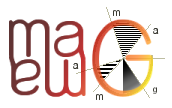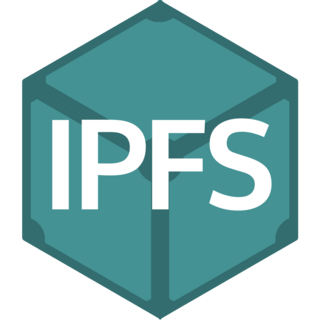Related Research Articles
In computing, a computer file is a resource for recording data on a computer storage device, primarily identified by its filename. Just as words can be written on paper, so can data be written to a computer file. Files can be shared with and transferred between computers and mobile devices via removable media, networks, or the Internet.

Hyphanet is a peer-to-peer platform for censorship-resistant, anonymous communication. It uses a decentralized distributed data store to keep and deliver information, and has a suite of free software for publishing and communicating on the Web without fear of censorship. Both Freenet and some of its associated tools were originally designed by Ian Clarke, who defined Freenet's goal as providing freedom of speech on the Internet with strong anonymity protection.

Peer-to-peer (P2P) computing or networking is a distributed application architecture that partitions tasks or workloads between peers. Peers are equally privileged, equipotent participants in the network, forming a peer-to-peer network of nodes.

A distributed hash table (DHT) is a distributed system that provides a lookup service similar to a hash table. Key–value pairs are stored in a DHT, and any participating node can efficiently retrieve the value associated with a given key. The main advantage of a DHT is that nodes can be added or removed with minimum work around re-distributing keys. Keys are unique identifiers which map to particular values, which in turn can be anything from addresses, to documents, to arbitrary data. Responsibility for maintaining the mapping from keys to values is distributed among the nodes, in such a way that a change in the set of participants causes a minimal amount of disruption. This allows a DHT to scale to extremely large numbers of nodes and to handle continual node arrivals, departures, and failures.

A cryptographic hash function (CHF) is a hash algorithm that has special properties desirable for a cryptographic application:
Kademlia is a distributed hash table for decentralized peer-to-peer computer networks designed by Petar Maymounkov and David Mazières in 2002. It specifies the structure of the network and the exchange of information through node lookups. Kademlia nodes communicate among themselves using UDP. A virtual or overlay network is formed by the participant nodes. Each node is identified by a number or node ID. The node ID serves not only as identification, but the Kademlia algorithm uses the node ID to locate values.
Files-11 is the file system used in the RSX-11 and OpenVMS operating systems from Digital Equipment Corporation. It supports record-oriented I/O, remote network access, and file versioning. The original ODS-1 layer is a flat file system; the ODS-2 version is a hierarchical file system, with support for access control lists,.
A distributed data store is a computer network where information is stored on more than one node, often in a replicated fashion. It is usually specifically used to refer to either a distributed database where users store information on a number of nodes, or a computer network in which users store information on a number of peer network nodes.

In computing, a file system or filesystem is a method and data structure that the operating system uses to control how data is stored and retrieved. Without a file system, data placed in a storage medium would be one large body of data with no way to tell where one piece of data stopped and the next began, or where any piece of data was located when it was time to retrieve it. By separating the data into pieces and giving each piece a name, the data are easily isolated and identified. Taking its name from the way a paper-based data management system is named, each group of data is called a "file". The structure and logic rules used to manage the groups of data and their names is called a "file system."
In computer science, consistent hashing is a special kind of hashing technique such that when a hash table is resized, only keys need to be remapped on average where is the number of keys and is the number of slots. In contrast, in most traditional hash tables, a change in the number of array slots causes nearly all keys to be remapped because the mapping between the keys and the slots is defined by a modular operation.
BitVault is a content-addressable distributed storage system, developed by Microsoft Research in China. BitVault uses peer-to-peer technology to distribute the tasks of storing and managing data. As such, there is no central authority responsible for management of the system. Rather, it is self-managing, provides high availability, reliability and scales up in a self-organizing manner, with low administrative overhead, which is almost constant irrespective of the size of the distributed overlay network.
Pastry is an overlay network and routing network for the implementation of a distributed hash table (DHT) similar to Chord. The key–value pairs are stored in a redundant peer-to-peer network of connected Internet hosts. The protocol is bootstrapped by supplying it with the IP address of a peer already in the network and from then on via the routing table which is dynamically built and repaired. It is claimed that because of its redundant and decentralized nature there is no single point of failure and any single node can leave the network at any time without warning and with little or no chance of data loss. The protocol is also capable of using a routing metric supplied by an outside program, such as ping or traceroute, to determine the best routes to store in its routing table.
Filesystem-level encryption, often called file-based encryption, FBE, or file/folder encryption, is a form of disk encryption where individual files or directories are encrypted by the file system itself.
Btrfs is a computer storage format that combines a file system based on the copy-on-write (COW) principle with a logical volume manager, developed together. It was founded by Chris Mason in 2007 for use in Linux, and since November 2013, the file system's on-disk format has been declared stable in the Linux kernel.

Magma is a distributed file system based on a distributed hash table, written in C, compatible with Linux and BSD kernels using FUSE.
In the BitTorrent file distribution system, a torrent file or meta-info file is a computer file that contains metadata about files and folders to be distributed, and usually also a list of the network locations of trackers, which are computers that help participants in the system find each other and form efficient distribution groups called swarms. Torrent files are normally named with the extension .torrent.
Object storage is a computer data storage approach that manages data as "blobs" or "objects", as opposed to other storage architectures like file systems which manages data as a file hierarchy, and block storage which manages data as blocks within sectors and tracks. Each object is typically associated with a variable amount of metadata, and a globally unique identifier. Object storage can be implemented at multiple levels, including the device level, the system level, and the interface level. In each case, object storage seeks to enable capabilities not addressed by other storage architectures, like interfaces that are directly programmable by the application, a namespace that can span multiple instances of physical hardware, and data-management functions like data replication and data distribution at object-level granularity.
Elliptics is a distributed key–value data storage with open source code. By default it is a classic distributed hash table (DHT) with multiple replicas put in different groups. Elliptics was created to meet requirements of multi-datacenter and physically distributed storage locations when storing huge amount of medium and large files.

The InterPlanetary File System (IPFS) is a protocol, hypermedia and file sharing peer-to-peer network for storing and sharing data in a distributed file system. IPFS uses content-addressing to uniquely identify each file in a global namespace connecting IPFS hosts.
References
- ↑ Cheung, Shun Yan. "Storing and Organizing Data Files on Disks". Emory University.
- 1 2 3 4 5 6 7 Zumwalt, Matt. "The Power of Content-addressing".
- ↑ Connor, Deni (29 May 2003). "Fixed content storage grabs users' attention". ComputerWorld.
- ↑ Content-addressable storage – Storage as I See it, by Mark Ferelli, Oct, 2002, BNET.com
- ↑ USENIX Annual Technical Conference 2003, General Track – Abstract
- ↑ CAS Industry standardization activities – XAM: http://www.snia.org/forums/xam
- ↑ Sheldon, Robert. "Content Addressed Storage".
- ↑ Making a hash of file content Content-addressable storage uses hash algorithms., By Chris Mellor, Published: 9 December 2003, Techworld Archived 28 September 2007 at the Wayback Machine Article moved to https://www.techworld.com/data/making-a-hash-of-file-content-235/
- ↑ "Venti: a new approach to archival storage". doc.cat-v.org. Retrieved 30 June 2019.
- ↑ "Twisted Storage". twistedstorage.sourceforge.net. Retrieved 30 June 2019.
- ↑ "HoneyComb Fixed Content Storage at OpenSolaris.org". Archived from the original on 12 October 2007. Retrieved 1 October 2007.
- ↑ "The XAM (eXtensible Access Method) Interface specification".
- ↑ A simple content-addressable storage system for .NET 4.5 and .NET Core: point-platform/cassette, Point Platform, 6 May 2019, retrieved 30 June 2019
- ↑ "Keep – Arvados". dev.arvados.org. Retrieved 30 June 2019.
- ↑ "Lennart Poettering Announces New Project: casync – Phoronix". Phoronix .